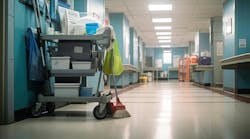Earth Day was launched more than 40 years ago and was designed to bring attention to one of this generation’s greatest challenges. Today, Earth Day remains an important event for many schools and universities, but much work must be done to turn the one-day celebratory opportunity into long-lasting and meaningful improvements.
One of the most important strategies necessary to transform Earth Day activities into ongoing success is helping students, staff, parents and other stakeholders understand how it affects them directly; broad, global issues such as resource depletion or melting icebergs sometimes seem to have little immediate or personal relevance. Strategies to keep in mind when trying to make a personal connection:
•Weather and local connections. Local weather such as droughts, floods or geographical conditions such as sensitive watersheds and water bodies can affect people’s lives directly and can be tied to improvements made by a green cleaning program. For example, if a campus is in an area suffering from severe drought, discuss green cleaning strategies that conserve water, such as the use of microfiber cleaning tools; carpet-extraction equipment that filter, recycle and reuse water; floor-stripping processes that use mechanical abrasion pads rather than chemical strippers and reduce total water use; and laundry and ware-washing equipment that are faster or use fewer cycles.
•Air pollution. Air pollution continues to adversely affect many urban areas. Make the connection to green cleaning by advocating use of chemicals that are low in VOCs (volatile organic compounds). Reduce or eliminate solvent-based cleaners, air fresheners or products high in fragrances and replace them with greener alternatives.
If the cause of local air pollution is attributed to vehicular traffic, focus communications on how green cleaning initiatives reduce pollution through better purchasing practices. Buying highly concentrated green cleaning chemicals and other products in bulk can reduce product delivery frequencies, which reduces pollution from vehicles.
If the local air pollution problem is caused by particulate matter, make the connection to the use of high-efficiency vacuums and vacuum cleaner bags that do a superior job capturing the smallest particles that can be inhaled. Or, focus on the use of microfiber cleaning and mopping tools that are superior in capturing particles, compared with more traditional paper products, sponges or cotton mops.
•Local economy. Make the connection to the local economy, and articulate messages properly to reduce the possibility of offending the community. For example, if a campus is in an area dependent upon forestry, promote the benefits of toilet tissues and paper hand towels derived from sustainably managed forests, as opposed to focusing on the use of recycled fiber, which the foresters might perceive as a threat to their business.
If the local economy is based on oil and gas exploration or chemical manufacturing, avoid suggesting that traditional chemicals are “bad” or harming people’s health or the environment. Rather, promote the positive benefits and importance of greener, safer and more healthful chemical cleaning products, especially if they have been certified by EcoLogo, EPA’s Design for the Environment Program or Green Seal, which have been tested to minimize negative effects on students, staff and the environment.
•Politics. In making the personal connection to green cleaning, be sensitive to local politics. In some parts of the country, the use of the term “green” is a negative and may create barriers that stop people from hearing the message.
If a school or university is situated in such an area, it is always a good idea to emphasize any financial benefits from using more concentrated chemicals, improving efficiencies, reducing absenteeism or lost worked time. Democrat or Republican, progressive or conservative, blue or red, everyone can relate to these values.


